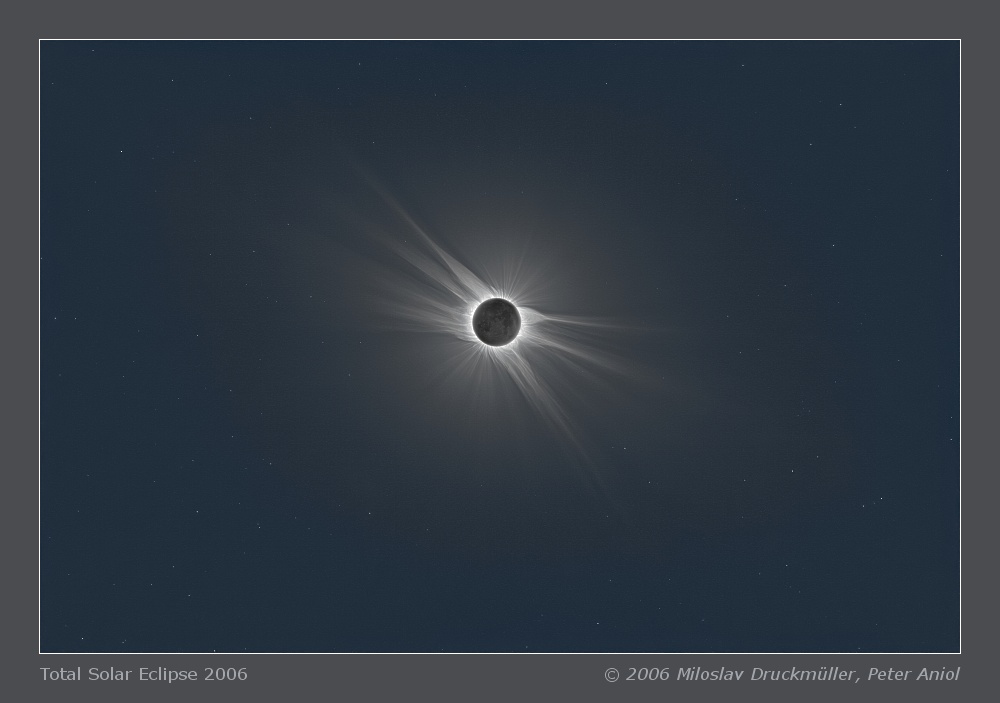
Solar corona up to 13 radii and 220 stars
This image is, up to this time, the most complicated and elaborate total solar eclipse image I have
created. It is a composition of totally 231 images taken by me and Peter Aniol in Libyan desert by
means of five Canon EOS 5D cameras equipped with 200 mm, 400 mm, 600 mm, 1240 mm
and 1640 mm lenses. The lens with the shortest focal length was Canon EF 200 mm 1:2.8 L II
stopped down to 5.6 aperture. The images are so sharp that the stars are nearly of one pixel size in
the original image. Therefore it makes nearly no sense to look at the picture in this page - you must
simply download the high resolution version in order to see all the stars and coronal details. The
horizontal size of the image is 39.3 solar radii and the coronal rays are visible up to 13 solar
radii. I identified totally 220 stars in the resulting image. The innermost part of the corona is
reconstructed from images taken with 1640 mm lens and it enabled to achieve maximum sharpness up
to the edge of the Moon. It would be impossible to use wide angle images only. The reason for it is
that the Moon is moving, the lunar edge is correctly recorded on a single image only and a single
image is not sufficient for high quality result. One single image taken with 1640 mm lens
down-sampled to 200 mm lens resolution has approximately the same signal to noise ratio as 8
images taken with 200 mm lens and it enables to achieve perfect results. The lunar surface is
clearly visible in all images taken with all lenses with long exposure time and therefore the Moon in
the resulting image is displayed in small details especially in the center of the lunar disc where
the images do not suffer from diffuse light caused by extreme contrast on the lunar edge. Both the
display of solar corona and the lunar surface is beyond the human vision ability during the eclipse
Click on the image or on the following reference to display the
higher resolution image version (3.2 MB, PNG format).
|
| Image | Tse2006l_39r3_102s_26d33_231n_v1.jpg |
| Date | 29. 03. 2006 |
| Time | 2nd contact 10:35:39 UT, 3rd contact 10:39:38 UT
Total eclipse duration 3 m 59.5 s |
| Place | Libya |
| Coordinate | 30° 56.946' N, 24° 14.301' E, 158 m altitude |
| Conditions | Excellent - clear sky, altitude of the Sun above the horizon 62° |
| Optics | 1) 16.4/1640mm (Takahashi 100 mm ED, focal length 820 mm with Canon 2× teleconverter) - 60 images
2) 12.2/1240 mm (TMB 102 mm focal length 620 mm with Baader FFC 2×) - 46 images
3)Canon EF 600 mm 1:4 L - 29 images
4)Canon Zoom Lens EF 100-400 mm 1:4.5-5.6 L IS (set to 400 mm) - 70 images
5)Canon EF 200 mm 1:2.8 L II - 46 images |
| Camera | Canon EOS 5D digital camera (ISO 100) - all lenses |
| Exposure | 1/1000 s - 8 s |
| Processing | Composition of 231 images. Eclipse images were aligned by means of phase correlation, composed by means of LDIC 4.0 software, processed using Corona 4.0 in order to visualize coronal structures. Final processing was done using ACC 6.0 software.
Image processing by Miloslav Druckmüller |
| Software | PhaseCorr 4.0, Corona_ret 2.0, LDIC 4.0, Corona 4.0, Sofo ACC 6.0 |
| Orientation | Image must be rotated 26.33° anti-clockwise to achieve standard orientation i. e. North up. |
| Copyright | © 2006 Miloslav Druckmüller, Peter Aniol |
|
Miloslav Druckmüller
Institute of Mathematics, Faculty of Mechanical Engineering
Brno University of Technology, Czech Republic
druckmuller@fme.vutbr.cz
|
Page last update: 27.11.2019
|
|

